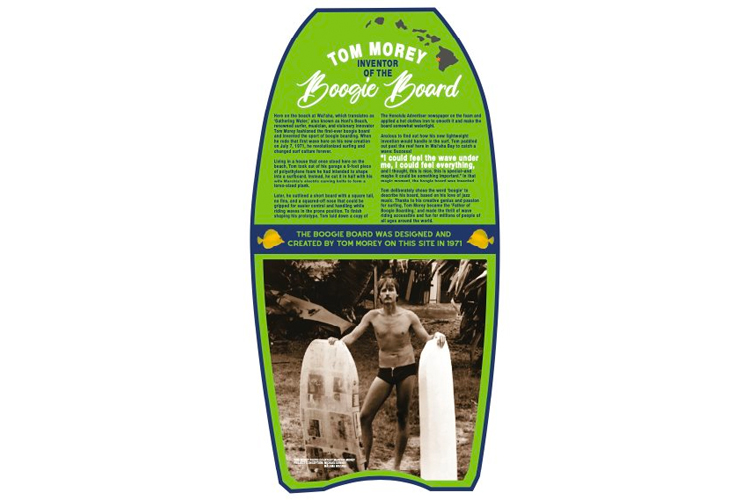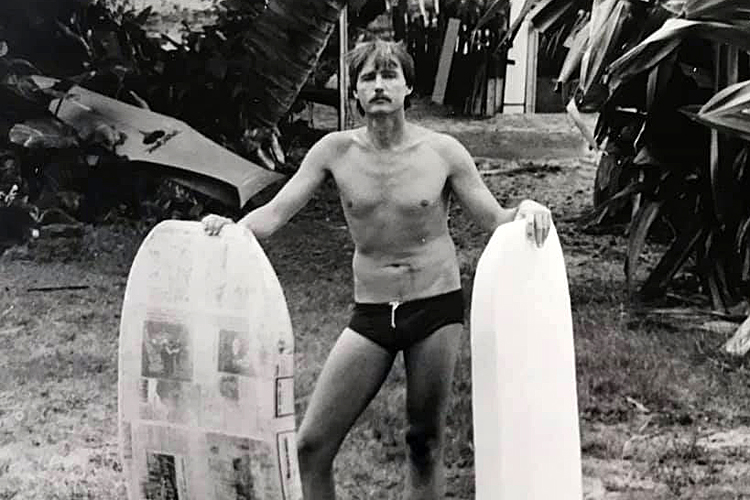The "Birthplace of the Boogie" plaque, a tribute to Tom Morey's revolutionary invention, has been erected at Honl's Beach Park in Hawaii.
The official sign installation and ceremony take place on November 6, 2021, at Honl's Beach in Kailua-Kona, Big Island.
Tom Morey was aware of the panel and edited every word of the interview conducted for the historic commemoration.
The six-foot-tall plaque tells the story of the boogie board (side A) and the origins of the ancient paipo board (side B).
For those around the world who are not able to read the sign in person, here's the eulogy in its full entirety.
The sign is of historical significance and importance for the sport of bodyboarding.
Tom Morey | Inventor of the Boogie Board
Side A
Here on the beach at Wai'aha, which translates as "Gathering Water," also known as Honl's Beach, renowned surfer, musician, and visionary innovator Tom Morey fashioned the first-ever boogie board and invented the sport of boogie boarding.
When he rode that first wave here on his new creation on July 7, 1971, he revolutionized surfing and changed surf culture forever.
Living in a house that once stood here on the beach, Tom took out of his garage a 9-foot piece of polyethylene foam he had intended to shape into a surfboard.
Instead, he cut it in half with his wife Marchia's electric carving knife to form a torso-sized plank.
Later, he outlined a short board with a square tail, no fins, and a squared-off nose that could be gripped for easier control and handling while riding waves in the prone position.
To finish shaping his prototype, Tom laid down a copy of The Honolulu Advertiser newspaper on the foam and applied a hot clothes iron to smooth it and make the board somewhat watertight.
Anxious to find out how his new lightweight invention would handle in the surf, Tom paddled out past the reef here in Wai'aha Bay to catch a wave: Success!
"I could feel the wave under me, I could feel everything, and I thought, 'This is nice. this is special, and maybe it could be something important.'"
In that magic moment, the boogie board was invented.
Tom deliberately chose the name 'boogie' to describe his board, based on his love of jazz music.
Thanks to his creative genius and passion for surfing, Tom Morey became the "The Father of Boogie Boarding" and made the thrill of wave riding accessible and fun for millions of people of all ages around the world.

The Oldest Known Paipo Board
Side B
Although the origins of surfing in Hawai'i remain shrouded in the mists of time, many historians believe that he'e nalu or "wave sliding" arrived in Hawai'i with the first Polynesian seafarers between 1000 and 1100 AD.
It is also believed that the earliest surfboards were papa li'ili'i - torso-sized wooden planks with rounded edges and no fins - now commonly called paipo boards.
Master carvers shaped these boards from the trunks of koa, wiliwili, or 'ulu trees after performing certain rituals, such as giving thanks to the tree and blessing its new life.
Possibly the oldest known surfboard (pictured left) is a paipo, 34.5 inches long, made of 'ulu wood, reportedly dating from the early to mid-1600s, discovered in the burial cave of High Chiefess Kaneamuna in Ho'okena on the South Kona coast.
An account of the discovery, titled "Sled of a Chiefess," appeared in the December 6, 1905 editions of several Honolulu newspapers:
"It is said that the oldest kamaainas of Hookena have heard from their parents and grandparents that sometime in the reign of King Keawenuiaumi, about two hundred and fifty or three hundred years ago, a high chiefess named Kaneamuna was living at Hookena. Her principal amusement was he'e holua (coasting on a sled) and he'e nalu (surfing). It is believed that the sled and board belonged to the High Chiefess."
The earliest first-person accounts of surfing in Hawaii come from the journals and logs of the crew of the HMS Resolution, which dropped anchor in Kealakekua Bay in January 1779 under the command of Captain James Cook.
The crew's writings describe in detail the skill and athleticism of the men, women, and children wave riding on wooden planks - paipo boards - in the prone position.
The paipo board is still popular today and is a recent ancestor of the modern boogie board.
